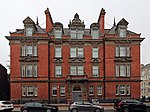Unity Theatre, Liverpool
Merseyside building and structure stubsTheatres in LiverpoolTourist attractions in LiverpoolUnited Kingdom theatre (structure) stubs

The Unity Theatre is a theatre in Liverpool, England. Formed by directors Gerry Dawson and Edgar Criddle as the Merseyside Left Theatre in the 1930s, the theatre became known as the Merseyside Unity Theatre in 1944. The company was known for being radical and experimentalist, staging classics alongside contemporary left-wing theatre; an aim was to make theatre accessible to the working class. Today, the theatre provides workshops and performance space and is based in a converted synagogue (the former home of Liverpool Reform Synagogue) on Hope Place off Hope Street.
Excerpt from the Wikipedia article Unity Theatre, Liverpool (License: CC BY-SA 3.0, Authors, Images).Unity Theatre, Liverpool
Back Hope Place, Liverpool Georgian Quarter
Geographical coordinates (GPS) Address External links Nearby Places Show on map
Geographical coordinates (GPS)
| Latitude | Longitude |
|---|---|
| N 53.401 ° | E -2.972 ° |
Address
The Unity Theatre
Back Hope Place
L1 9BG Liverpool, Georgian Quarter
England, United Kingdom
Open on Google Maps








